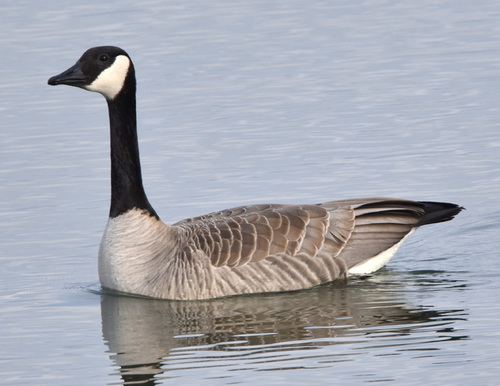
Canada Goose
The Canada Goose (Branta canadensis) is a large wild goose species native to North America. It is known for its distinctive black head and neck, white chinstrap, and brownish-gray body. These geese are highly adaptable and can be found in a variety of habitats, from urban parks to Arctic tundra. Ecologically, they play a role in seed dispersal and nutrient cycling, grazing on vegetation and providing a food source for predators. While once declining in numbers, conservation efforts have led to a significant population rebound, sometimes resulting in overpopulation in certain areas, creating conflicts with human interests.
75-110 cm
Length
127-185 cm
Wingspan
Least Concern
Conservation Status
Distribution
Native to North America, breeding across Canada and the northern United States. They migrate south for the winter, reaching as far as Mexico. Introduced populations have also become established in parts of Europe, including Great Britain, Scandinavia, and New Zealand.
Lifespan
10-24 years in the wild; can exceed 30 years in captivity.
Canada Goose's Habitat
Habitat Types
Wetlands, Lakes, Rivers, Ponds, Marshes, Agricultural fields, Urban parks, Coastal areas
Climate Zones
Arctic, Subarctic, Temperate, Subtropical
Adaptations
Canada Geese are highly adaptable to different environments. Their dense, downy feathers provide insulation in cold climates. They have webbed feet for efficient swimming and a broad bill adapted for grazing on a variety of vegetation.
Variations
Several subspecies of Canada Goose are recognized, differing in size and plumage details. For example, the Giant Canada Goose (B. c. maxima) is significantly larger than other subspecies, while others may have darker or lighter body plumage.
Appearance
Breeding Plumage
Plumage is similar year-round.
Seasonal Feather Changes
No significant seasonal variations, but molting occurs after breeding, rendering them flightless for a period.
Sex Based Plumage Differences
Limited sexual dimorphism; males and females have similar plumage.
Notable Features
Black head and neck, White chinstrap extending from ear to ear, Brownish-gray body plumage, White undertail coverts, Black bill and legs
Diet and Feeding
Primary Foods
Grasses, Sedges, Aquatic plants, Grains, Berries, Seeds, Small insects (especially for goslings)
Foraging Behavior
Primarily grazes on land, but also feeds in water by dabbling or submerging its head and neck. Often feeds in flocks, especially during migration and winter.
Specializations
The bill has serrated edges, which help in tearing and consuming grasses and other vegetation.
Seasonal Diet Variations
Diet varies seasonally depending on food availability. In winter, they may rely more on grains and agricultural crops, while in summer, they consume more grasses and aquatic plants.
Behavior
Social Structure
Highly social, especially outside of the breeding season. Forms large flocks during migration and winter. Family groups remain together throughout the year.
Communication
Loud honking calls, Neck-stretching, Head-pumping, Wing displays, Hissing (when threatened)
Migration
Migratory, flying in V-formations. Migrates south for the winter and returns north to breed in the spring. Migration routes and timing vary depending on population and weather conditions.
Territorial or Group Behaviors
During the breeding season, pairs are territorial and defend their nesting area. Outside of breeding, they are highly gregarious and form large flocks.
Conservation
Threats
Habitat loss (historical), Hunting (regulated), Collisions with vehicles and structures, Lead poisoning (from ingestion of lead shot)
Protection Programs
Migratory Bird Treaty Act (in the US and Canada), Hunting regulations, Habitat restoration and conservation efforts
Local National Laws
Protected under the Migratory Bird Treaty Act in the United States and Canada.
Population Trend
Increasing
Population Estimates
Estimated at over 7 million individuals in North America.
Interesting Facts
Canada Geese can fly at speeds up to 70 mph (113 km/h) during migration.
This allows them to cover long distances quickly.
They form strong pair bonds and often mate for life.
This contributes to their reproductive success.
Goslings can swim within hours of hatching.
This is an important adaptation for survival, allowing them to escape predators and access food.
The "V" formation during flight helps conserve energy.
Birds in the formation benefit from the updraft created by the bird in front.
Canada Geese have successfully adapted to urban environments.
This has led to increased populations in some cities, sometimes causing human-wildlife conflicts.
Faqs about Canada Goose
Why do Canada Geese fly in a V formation?
Flying in a V formation reduces wind resistance and allows the geese to conserve energy during long flights. The lead bird breaks the wind, creating an updraft that benefits the birds behind it.
Are Canada Geese aggressive?
Canada Geese can be aggressive, especially during the breeding season when they are protecting their nests and young. They may hiss, honk, and even charge at perceived threats.
What should I do if I encounter a Canada Goose nest?
It's best to give Canada Goose nests a wide berth. Do not approach or disturb the nest or the geese. If you accidentally get too close, back away slowly and calmly.
Is it okay to feed Canada Geese?
It is generally not recommended to feed Canada Geese. Feeding them can lead to nutritional problems, habituation to humans, and overpopulation in certain areas. It's best to let them find their natural food sources.
How can I tell a male Canada Goose from a female?
It can be difficult to distinguish between male and female Canada Geese based on appearance alone. Males are generally slightly larger and may have a slightly thicker neck, but these differences are subtle. Behavioral cues, such as the male's more aggressive defense of the nest, can be more reliable indicators.
Copyright @ Nature Style Limited. All Rights Reserved.
 English
English